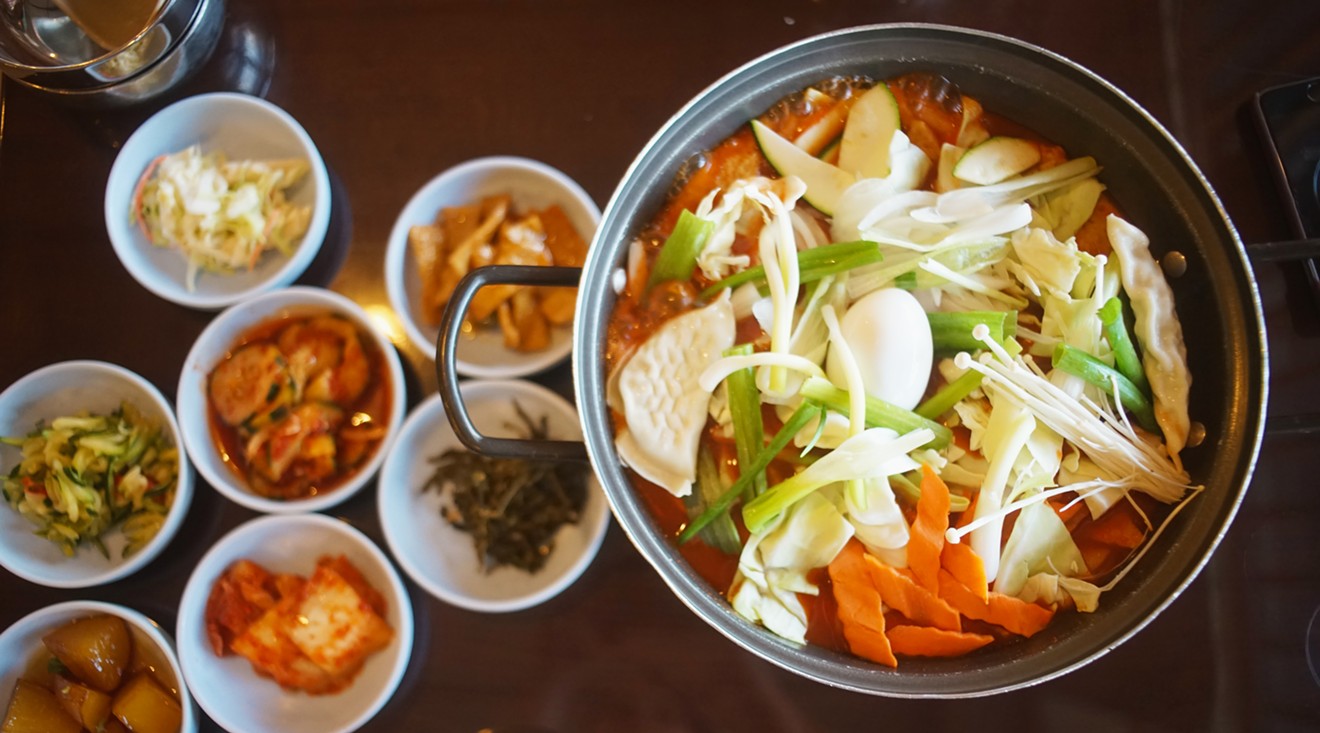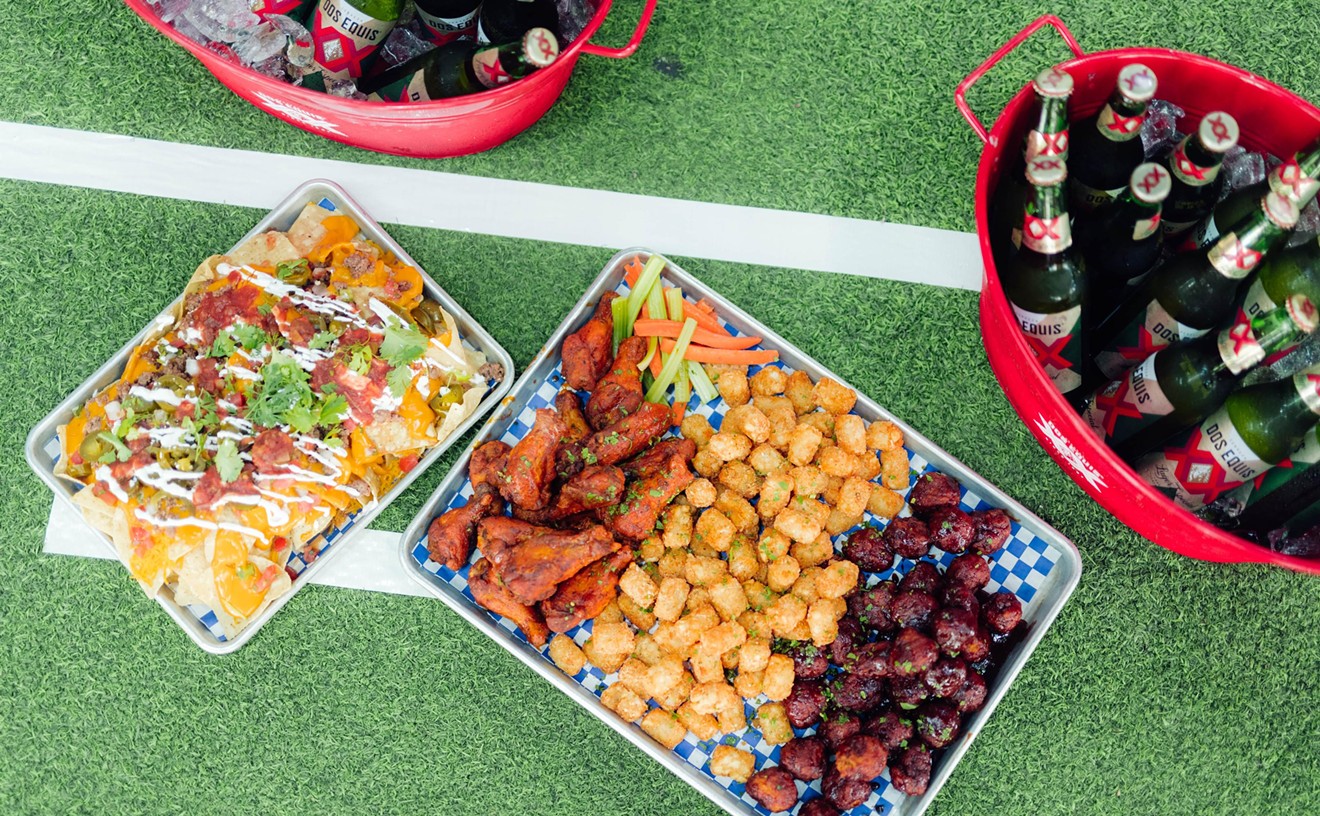Cuisine: Korean
Restaurant Name Keywords: Korean, Korean barbecue
Menu Keywords: Kimchi, Gogi, Jjigae, Bap, Myeon
What is Korean Food?
It’s not uncommon for a Korean conversation to start with, “Have you eaten?” It’s usually not literal, but rather a way of asking about someone’s day, like saying, “How are you?” This simple greeting underscores how important traditional food has remained, even as Korea’s politics, economy, and culture have changed dramatically over time. As ever, to be fed is to be well.
Because winters in Korea are long and harsh, many foods traditionally had to be preserved to maintain a consistent food supply. The resulting cooking techniques produce pungent, complex flavors, with meals that are spicy, sour, briny, sharp, and sweet. In general, Korean dishes have a lot of flair and are rarely subtle.
Korean cuisine has prehistoric roots, with the ubiquitous fermented cabbage dish kimchi dating back thousands of years, and though the peninsula’s food has continued to evolve since then, it remains based on short-grain rice, meat and fish, and seasonal or fermented vegetables. Common ingredients include pepper flakes and pastes, sesame oil, garlic, ginger, soy sauce, bean paste, kelp, and anchovies.
Despite their close physical proximity, Korea and Japan do not have much in common when it comes to the kitchen. So, restaurants that offer both cuisines are not the places to go for authentic Korean food. As a general rule of thumb, if the sign outside advertises sushi, it’s probably not the real deal.
Step inside a Korean restaurant and you will see primarily large tables, with far fewer two-tops and bar seats than you'd find at other restaurants. That's because, for Koreans, dining out is as much about socializing as it is about eating, making it highly unusual to see an individual sitting alone for a meal. Many menus have combo items that are meant to be shared, and your server may give you a funny look if you come in for a solo snack. Going out for Korean as a couple is great, but having a group of at least three makes for the best experience.
Drinking is also a big part of Korean life and food culture. Certain dishes are typically paired with a corresponding booze. For instance, fried chicken calls for Korean beer; pancakes, called pajeon, require makgeolli rice wine; and grilled pork is perfect with a stiff shot of soju liquor. Not only does the alcohol pair nicely with the cuisine, but it’s also a great warm-up if the second stop of the night happens to be a Korean-style karaoke room.
There are more and more Korean restaurants here in Phoenix. Three great places to start your sampling are:
Hodori, Mesa
Go for: Well-priced mains with huge portions. Jungol casseroles easily feed two. Don’t miss the mackerel or the house specialty tofu soup. (Plus, it’s next to Asiana Market, an amazing place to shop for Korean ingredients, sweets, and snacks like bulgogi potato chips.)
Chodang, Chandler
Go for: Soft tofu soups, multiple varieties of bulgogi (grilled meat), and bibimbap (mixed rice), cold noodles, dumplings, and spicy stews.
Sizzle Korean Barbecue, Phoenix
Go for: Grilled meats in an upscale environment. Servers tend the grill at each table. Ask for rice and ssam (leaves for wrapping) on the side.

Various side dishes, kimchi jjigae, rice, and lettuce leaves for wrapping surround the meat at the grilling table in Sizzle Korean Barbecue in Phoenix.
Meagan Mastriani
Tips: Most Korean menus list items in romanized characters with a brief explanation. Spicy dishes are typically noted with pepper icons. It is customary to order family-style and share all the food as a table. Feel free to dig right in with your chopsticks (or your spoon, if eating rice or soup), or ask for a small bowl if you’d prefer to take your portion that way. Meals come with a variety of complimentary side dishes, called banchan, and most places will refill them on request. Be aware that you may have to call or signal if you need your server’s attention. Some tables have a bell or buzzer to press for service.
STARTERS
Jeon: Known as Korean “pancakes,” jeon are foods battered with egg and flour and fried in oil. These large, savory discs are meant to be sliced or torn to share among a group. The most common varieties are haemul pajeon, loaded with scallions, squid, clams, oysters, and other seafoods; and kimchijeon, packed with bits of spicy fermented cabbage and sometimes ground pork. Jeon come with a small cup of delicious salty dip, traditionally made from a blend of soy sauce, rice vinegar, honey, garlic, and sesame oil or seeds.
Mandu: Mandu refers to any kind of dumpling – boiled, steamed, or fried. Styles vary from place to place, ranging from hefty pockets of pork and greens to crispy browned half-moons stuffed with kimchi. Mandu guk is a simple, comforting soup with boiled dumplings in a light beef or anchovy broth.
Ddeokbokki (or dduk bok e/tteok-bokki): These chewy, cylindrical rice cakes come slathered in spicy red pepper sauce and are the ultimate junk food delight. (Pro tip for parents: Kids go crazy for this stuff.) Though it originated on the streets of Korea, served in a humble paper cup, ddeokbokki has made its way onto restaurant menus and refined versions of this popular fast food may include the addition of fish cakes, boiled eggs, vegetables, or instant noodles.

A pot of piping hot doenjang jjigae surrounded by various banchan at Hodori in Mesa.
Meagan Mastriani
Bibimbap: The name of this dish translates to “mixed rice." The colorful bowl is constructed with a base of white rice topped with julienned and sauteed vegetables, sprouts, mushrooms, a raw or fried egg, and an optional meat (usually beef). When the bowl arrives, the ingredients are separated and beautifully arranged, and though it may be tempting not to disturb the presentation, the first thing you should do is vigorously mix everything together (hence, the name). Then, reach for the accompanying bottle of spicy red pepper sauce and squeeze on as much as you can handle. Many restaurants also offer a dolsot “hot stone” bibimbap that comes out sizzling in a small black pot coated with sesame oil. The slightly burnt rice at the bottom is a real treat, but be advised that this is an extremely hot dish. Eat slowly and do not touch.
Jjigae (or chigae): You’ll probably see a whole menu section devoted to jjigae, or stew. Every place does jjigae a little differently, but it’s always bubbling hot and full of rich, deep flavors. Try the classic kimchi jjigae, which is traditionally made with older (more “ripe”) kimchi, for a sour burst of probiotic goodness. Fans of funky fermented flavors will also like doenjang jjigae, with its pungent soybean paste and tofu cubes. Or go for budae jjigae, “army stew,” a post-Korean War specialty with ingredients scrounged from U.S. military bases, including Spam, hot dogs, American cheese slices, baked beans, instant noodles, and more. (Note: Many stews contain meat or seafood, even if not included in the menu description. Don’t be surprised to find a shrimp head floating up top or mussel shells on bottom. Broth is commonly made from beef or anchovies, so check with your server if you’re vegetarian or allergic.)
Soondubu: Though technically a kind of jjigae, we found soondubu often has a whole menu category to itself at places in the Phoenix metro area. The silky, extra soft tofu swims in red broth and is served in black stone hot pots. At most restaurants, there’s a soondubu variety for everyone: seafood, beef, pork, and even vegetarian (a rare option in Korean cuisine). You can customize your level of spiciness and specify if you want a raw egg to cook in the stew, which will arrive still boiling. If you want to look like a pro, take a spoonful of the white rice they give you on the side and soak it in the soondubu broth for a few seconds before eating.
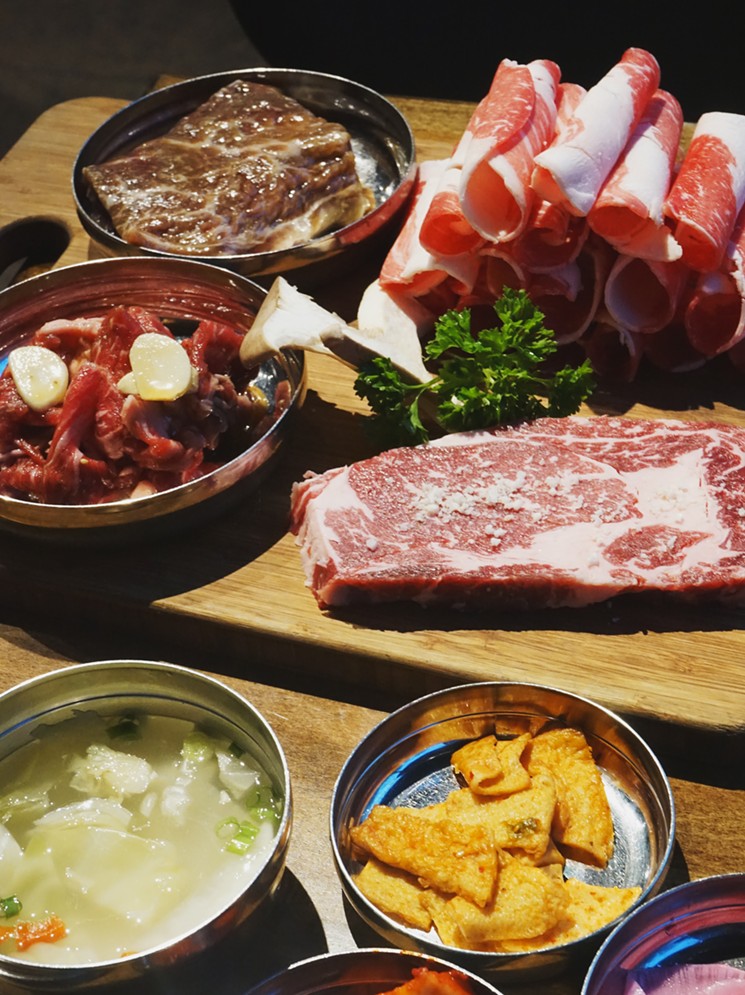
The beef combo at Sizzle Korean Barbecue in Phoenix includes four cuts of meat, a stew, and various side dishes.
Meagan Mastriani
Naengmyeon (or naengmyun): Icy (“naeng”) noodles (“myeon”) are served only in summer in Korea, but here in Arizona you can get them year-round. On a hot day, you’ll be instantly refreshed just by the beads of sweat coating the stainless steel bowl and the sound of crushed ice sloshing around inside. Naengmyeon features a tangy, chilled broth; long, thin noodles usually made of buckwheat or sweet potato starch; slices of cucumber and pickled radish; a boiled egg; and sometimes cold beef. You may also receive a bottle of spicy mustard or a kettle of vinegar to add for extra zing. Bibim naengmyeon is a common variety that incorporates spicy red pepper sauce.
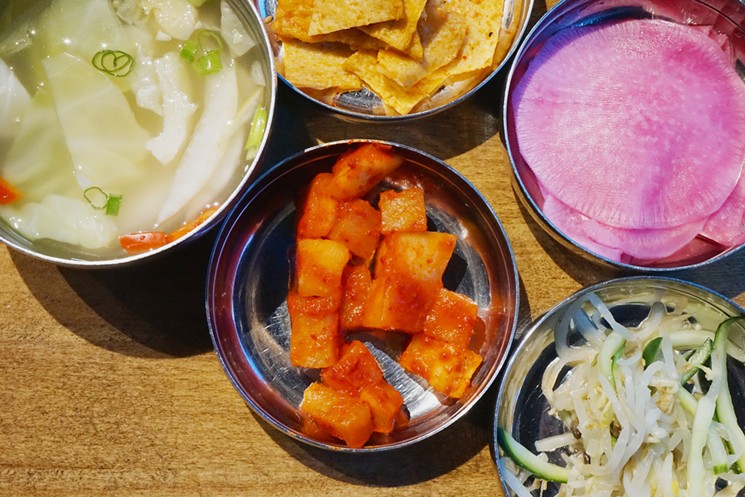
Side dishes at Sizzle Korean Barbecue in Phoenix may include radish kimchi (center), as well as cold soup, fish cakes, pickled radish discs, and sautéed bean sprouts (clockwise from left).
Meagan Mastriani
Kimchi: Technically, kimchi is any salted and fermented vegetable, though the most common variety is made with Napa cabbage. No Korean meal is complete without this sour, spicy, vitamin-rich essential, either as a side dish or part of a main. Be ready for a tongue explosion, as kimchi contains a medley of extremely strong flavors, from sea salt, chili flakes, garlic, ginger, scallions, and often seafood paste – all of which have fermented together for weeks or months in a large stone pot. (For picky eaters, it may be an acquired taste.) In addition to being delicious, kimchi is also low in calories and high in fiber and probiotics.
Gochujang/ssamjang: The thick red pastes served with many bowls and meats are gochujang and ssamjang. Gochujang is made with chili powder, rice, salt, and powdered fermented soybeans, so it tastes spicy, sweet, and savory at the same time. Apply this condiment liberally for a punch of heat and umami. Ssamjang is a similar sauce that contains gochujang, along with more fermented soybeans, sesame oil, garlic, and onions. “Ssam” means “wrapped,” and ssamjang goes great with bites of barbecue wrapped up in large lettuce leaves or other greens.
Banchan: The Korean table is highly photogenic, thanks largely to banchan, the assorted side dishes served with every meal. Most restaurants bring out at least five sides, which change daily according to what’s in season and in stock. There are several types of banchan, including marinated or seasoned cooked vegetables, steamed or boiled eggs and fish, simmered and glazed meat or potatoes, and many more. Sampling these diverse dishes might become your favorite part of the meal, and if you run out, you can ask for seconds.
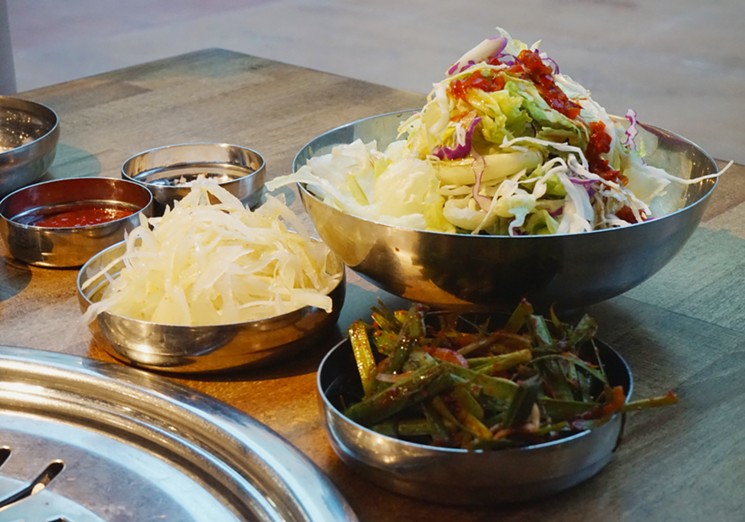
Dinners at Sizzle Korean Barbecue in Phoenix come with a side salad dressed in gochujang and chopped onions and scallions to pair with grilled meats.
Meagan Mastriani
Soju: If you look around a Korean restaurant and see tables topped with green glass bottles, you’ll know you’re in a good place. Those bottles are for soju, a clear rice liquor that is a great complement to any dinner, but especially barbecue. Take shots, sip it neat, or mix it with beer to make somaek. Soju etiquette in Korea can be strict – including rules about who should pour drinks (the youngest), how to hold the cup (with two hands), and so on – but nobody here will judge you as long as you toast cheerfully and often. Just be careful: This stuff is stronger than it seems.
Makgeolli: Larger white or green plastic bottles may contain makgeolli, a slightly sweet, milky white Korean rice wine. It’s traditional to drink makgeolli with pajeon, or Korean pancakes, though it pairs well with many meals and can be particularly refreshing with spicy dishes. Depending on the variety of makgeolli, it can be more tart, more fizzy, or more watery or thick, so try a few kinds before settling on a favorite. You may also find bits of rice grain at the bottom, so be sure to swirl the bottle a few times before pouring it. Some restaurants may serve makgeolli in a large wooden or metal bowl with a ladle and cups or small bowls (you can pick up the bowl with both hands and sip directly from it).
Yakult: Though yakult isn’t listed on most Korean menus, it’s fairly common for servers to bring it out as a gift at the end of a meal. It’s a probiotic dairy drink, like a thinner and much sweeter version of plain yogurt, that comes in a mini plastic bottle with a foil cap. Pierce the cap with a straw or peel it back to drink the yakult. Some consider yakult a health product, as the “good” bacteria helps with digestion, though others say that benefit is negated by its high sugar content. Either way, it makes for a light and tasty dessert.
Learn More About Korean Cuisine
To really appreciate a cuisine, it is often quite enlightening to try your hand at cooking a dish or two. When it comes to Korean food, the YouTube star and cookbook author Maangchi is a great resource for beginners. Check her website for recipes and videos covering some of the most basic and beloved dishes. For the advanced cook, bburi kitchen offers an in-depth and historical look at seasonal Korean ingredients and cooking tecnhiques, plus stunning photography. Look up a recipe on either site and then head to the Asiana Market in Mesa or Glendale to pick up your ingredients.

